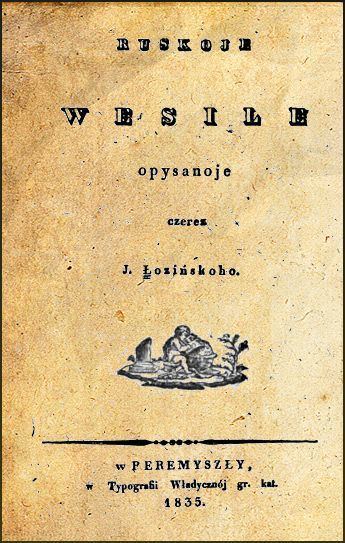 | ||
A Latin alphabet for the Ukrainian language (called Latynka) has been proposed or imposed several times in the history in Ukraine, but has never challenged the conventional Cyrillic Ukrainian alphabet.
Contents
Characteristics
The Ukrainian literary language has been written with the Cyrillic script, in a tradition going back to the introduction of Christianity and the Old Church Slavonic language to Kievan Rus’. Proposals for Latinization, if not imposed for outright political reasons, have always been politically charged, and have never been generally accepted. Although some proposals to create an official Latin alphabet for Ukrainian language have been expressed lately by national intelligentsia. Technically, most have resembled the linguistically related Polish and Czech alphabets.
While superficially similar to a Latin alphabet, transliteration of Ukrainian from Cyrillic into the Latin script (or romanization) is usually not intended for native speakers, and may be designed for certain academic requirements or technical constraints. See romanization of Ukrainian.
History
Ukrainian was occasionally written in the Latin script as far back as the sixteenth and seventeenth centuries, in publications using the Polish and Czech alphabets. In the nineteenth century, there were attempts to introduce the Latin script into Ukrainian writing, by Josyp Łozynśkyj, a Ukrainian scholar and priest from Lviv (Josyp Łozynski Ivanovyč, Ruskoje wesile, 1834), Tomasz Padura, and other Polish-Ukrainian romantic poets.
The use of the Latin script for Ukrainian was promoted by authorities in Galicia under the Austrian Habsburg Empire. Franc Miklošič developed a Latin alphabet for Ukrainian in 1852, based on the Polish and Czech alphabets (adopting Czech č, š, ž, dž, ď, ť, Polish ś, ź, ć, ń, and ľ following the same pattern). This initiative was taken into interest by Czech politician Josef Jireček, who managed to gain support for the project in the Imperial Ministry of Interior. As part of a Polonization campaign in Galicia during the period of neo-absolutist rule after 1849, Viceroy Agenor Gołuchowski attempted to impose this Latin alphabet on Ukrainian publications in 1859. This started a fierce publicly debated "War of the Alphabets", and in the end the Latin alphabet was rejected. Ukrainian books continued to be published in Cyrillic, while the Latin alphabet was used in special editions "for those who read Polish only" in Galicia, Podlaskie, and the Chełm region.
A Latin alphabet for Ukrainian publications was also imposed in Romanian Bessarabia, Bukovina and Dobrudja, Hungarian Zakarpattia. It was also used by immigrants from these regions in the United States.
In Ukraine under the Russian Empire, Mykhailo Drahomanov promoted a purely phonemic Cyrillic alphabet (the Drahomanivka) including the Latin letter ј in 1876, replacing the digraphs я, є, ю, ї with ја, је, ју, јі, similar to the earlier Karadžić reform of the Serbian alphabet. The Ems Ukaz banning Ukrainian-language publication doomed this reform to obscurity.
In Soviet Ukraine, during the 1927 orthographical conference in Kharkiv, linguists M. Johansen, B. Tkačenko, and M. Nakonečnyj proposed the application of the more "international" Latin script to Ukrainian, but the idea was opposed by Soviet government representatives. Later, Vasyl Simovych was a proponent of the Latin script during the tentative latinization in the USSR.
Abecadło
Some letters borrowed from Polish were used in the Ukrainian Łatynka as stated above, which also has a close resemblance to the Belarusian Łacinka. Although never broadly accepted, it was used mostly by Ukrainians living in territories near Poland (where it was called Abecadło). The orthography is explained in Łatynycia, a western Ukrainian publication of the 1900s.
As example, the Introduction of Josyp Łozynśkyj's Ruskoje Wesile ('Ruthenian Wedding', 1834):
Perédmowa W tym opysi skazuju, jaksia wesile po sełach meży prostym ruskim ludom widprawlaje. Ne mohu jednako utrymowaty, jakoby toj sposób wesile widprawlaty wsiude newidminni był zachowanym; bo hdenekodyj szczoś dodajut, hdeinde szczoś wypuskajut, a znowu hdeinde szczoś widminiajut. Syła w mojej syli było, starał-jemsia w rozmaitych misciach obradki i pisny ruskoho wesila póznaty i pérekonał-jemsia że prynajmni szczo do hołownych obradkiw i pisnéj wsiude tymże samym sposobom wesilesia widprawlaje. I toj sposób opysałjem w nynijszуj knyżoczci dodajuczy jednako hdenekodyj i miscowyi widminy. Moim najperszym i najbohatszym a nawet́ i nihdy newyczerpanym źridłom, z kotorohom tyi widomosty czerpał, było dopytowanie po sełach tych ludej, kotryi czasto na wesilach bywały i wesilnyi uŕady pistowały. Nykotorych obradkiw był jem sam okozritelnym świdkom.Jireček's project
Josef Jireček proposed an alphabet based more closely on Czech orthography (except some Polish letters like ć, ń, ś, ź).
Modern versions
In modern Ukraine, use of Latin alphabets for the Ukrainian language is very rare. However, discussions of united format of Latynka and its status still continue. The most popular modern versions are Luchukivka (based on Jireček's project and presented by Ivan Luchuk) and Ukrainian Gajica (based on Gajica).
Comparison
Comparison of two traditional and two modern versions of Ukrainian Latin alphabet in example of the national anthem of Ukraine.
